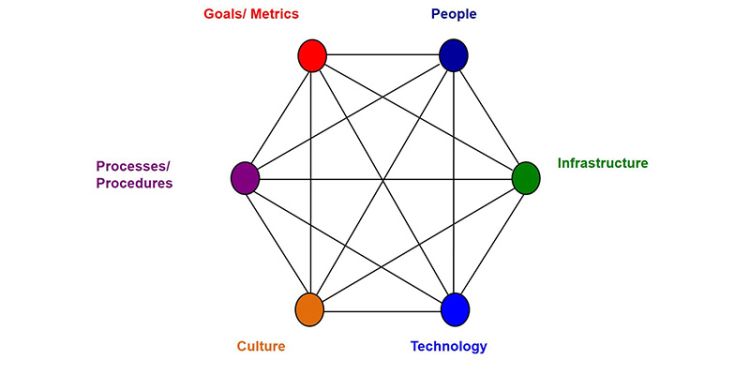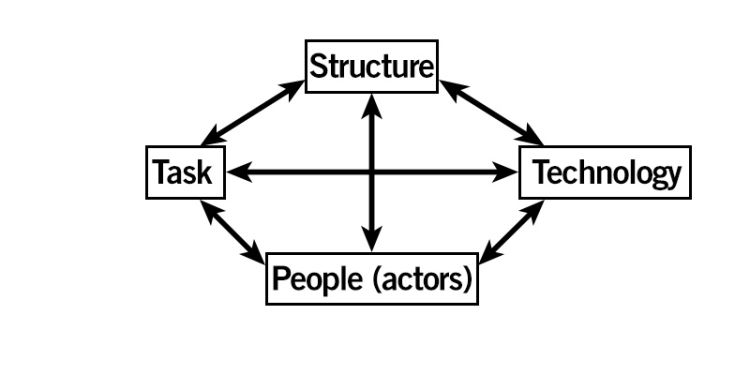Within the STC we adopt a systems view of organisations, represented by the hexagon. It is this hexagon that lies at the heart of our thinking.
Within a socio-technical systems perspective, any organisation, or part of it, is made up of a set of interacting sub-systems, as shown in the diagram below. Thus, any organisation employs people with capabilities, who work towards goals, follow processes, use technology, operate within a physical infrastructure, and share certain cultural assumptions and norms.

Socio-technical theory has at its core the idea that the design and performance of any organisational system can only be understood and improved if both ‘social’ and ‘technical’ aspects are brought together and treated as interdependent parts of a complex system.
Organisational change programmes often fail because they are too focused on one aspect of the system, commonly technology, and fail to analyse and understand the complex interdependencies that exist.
This is directly analogous to the design of a complex engineering product such as a gas turbine engine. Just as any change to this complex engineering system has to address the knock-on effects through the rest of the engine, so too does any change within an organisational system.
There will be few, if any, individuals who understand all the interdependent aspects of how complex systems work. This is true of complex engineering products and it is equally true of organisational systems. The implication is that understanding and improvement requires the input of all key stakeholders, including those who work within different parts of the system. ‘User participation’ thereby is a pre-requisite for systemic understanding and change and, in this perspective, the term ‘user’ is broadly defined to include all key stakeholders.
The potential benefits of such an approach include:
- Strong engagement
- Reliable and valid data on which to build understanding
- A better understanding and analysis of how the system works now (the ‘as is’)
- A more comprehensive understanding of how the system may be improved (the ‘to be’)
- Greater chance of successful improvements
The socio-technical perspective originates from pioneering work at the Tavistock Institute and has been continued on a worldwide basis by key figures such as Harold Leavitt, Albert Cherns, Ken Eason, Enid Mumford and many others.
Our use of the hexagon draws heavily on the work of Harold, J. Leavitt who viewed organisations as comprising four key interacting variables, namely task, structure, technology and people (actors).

We have used this systems approach in a wide range of domains including overlapping projects focused on:
- Computer systems
- New buildings
- New ways of working
- New services
- Behaviour change
- Safety and accidents
- Crowd behaviours
- Organisational resilience
- Sustainability (energy, water and waste)
- Green behaviours at work and in the home
- Engineering design
- Knowledge management
- Tele-health
- Social networks
- Organisational modelling and simulation
- Supply chain innovation
- Risk analysis
- Performance and productivity
- Process compliance
A systems perspective is an intellectually robust and useful way of looking at organisations. It speaks well to our clients and provides a coherent vehicle for collaboration with other disciplines, most obviously with our engineering colleagues. Our experience is that most of the difficult problems and exciting opportunities we face in the world lie at the intersections between human behaviour and engineering innovation. Systems theory provides a useful tool to help us understand and address these challenges.

